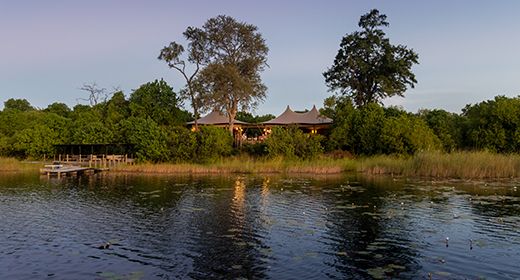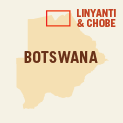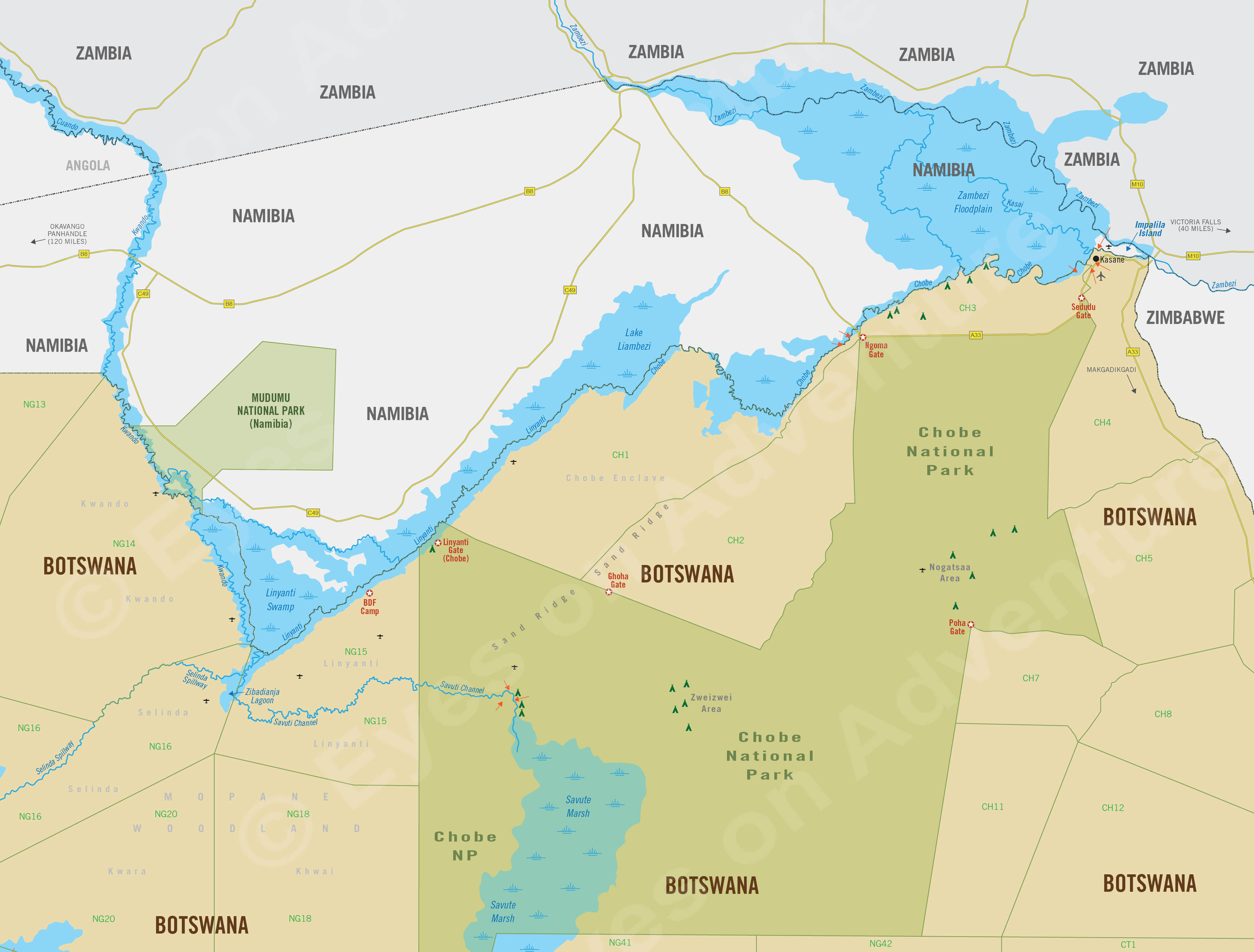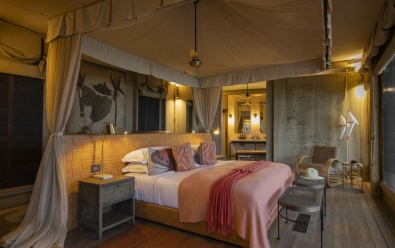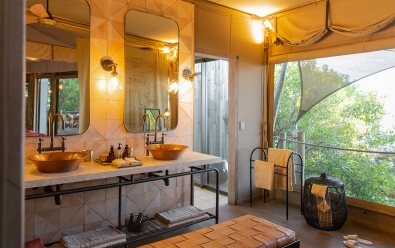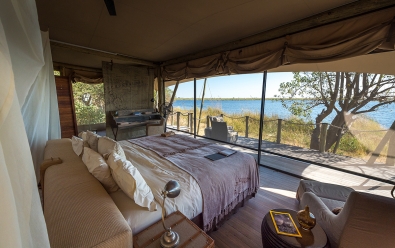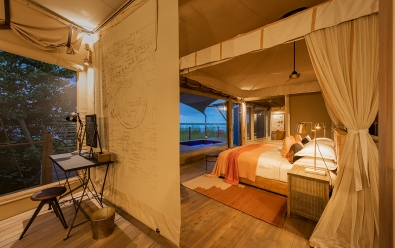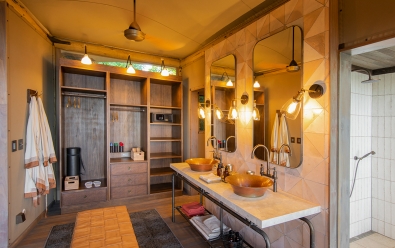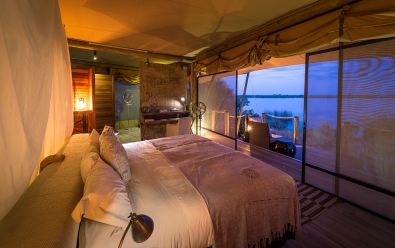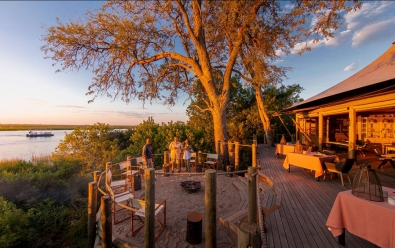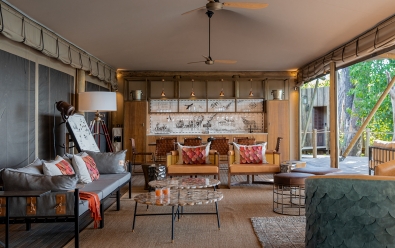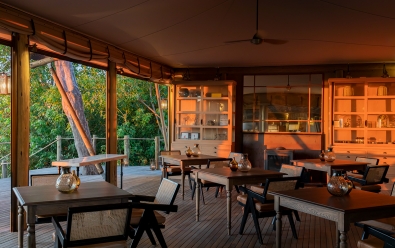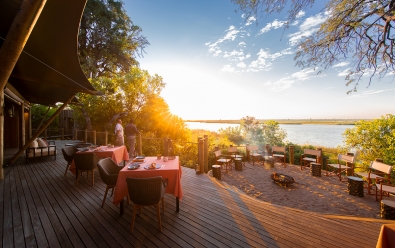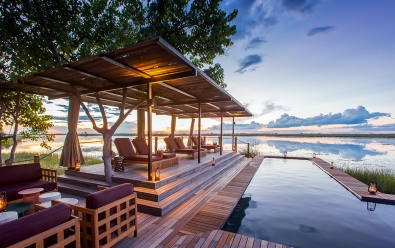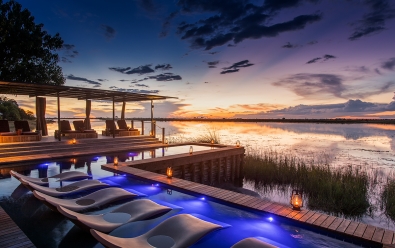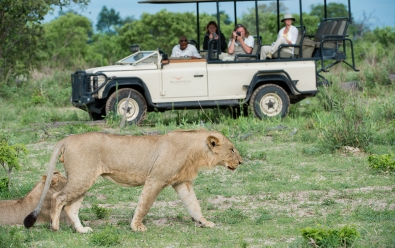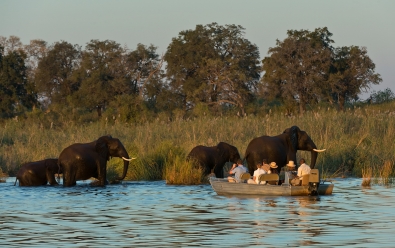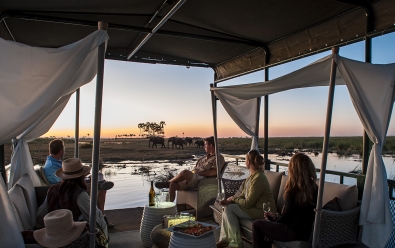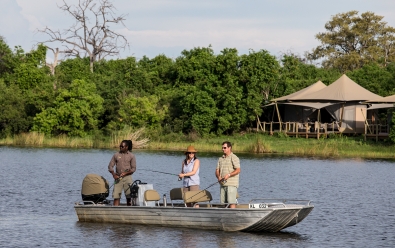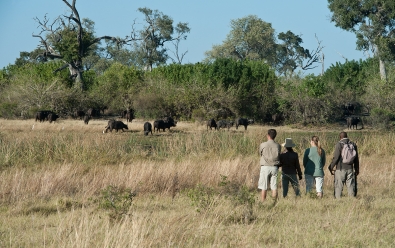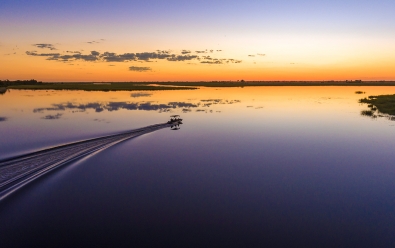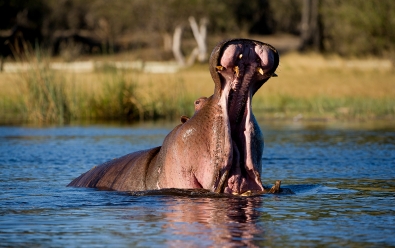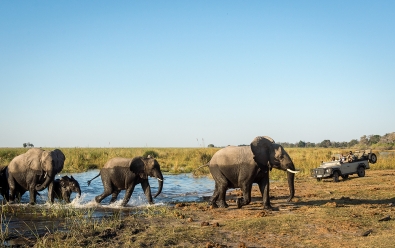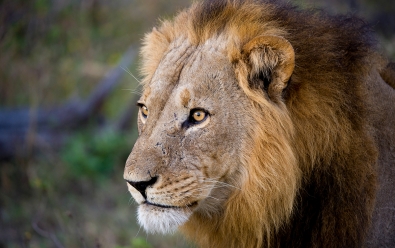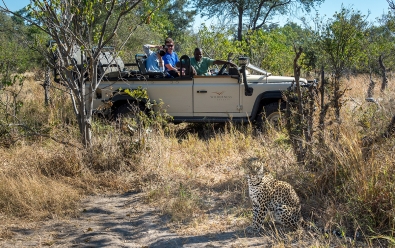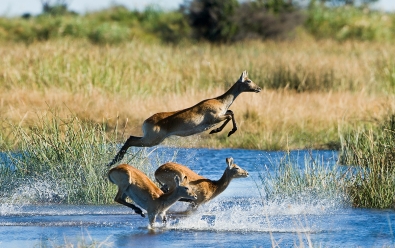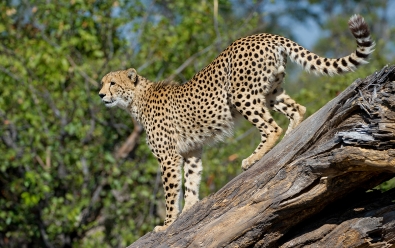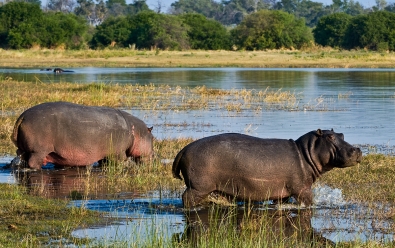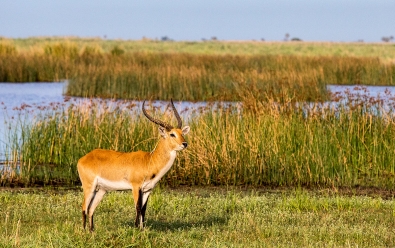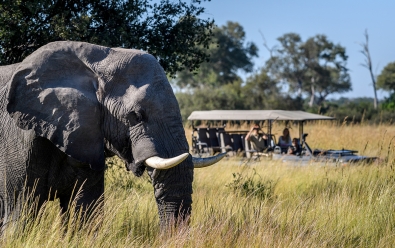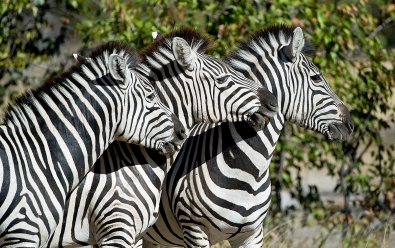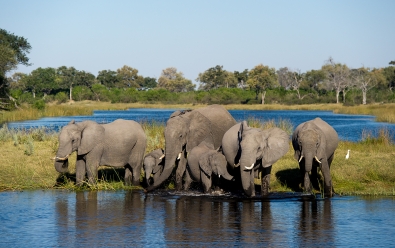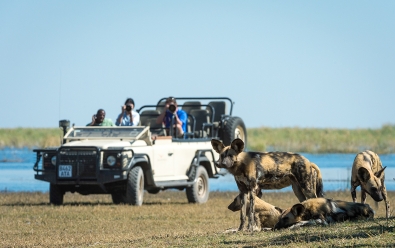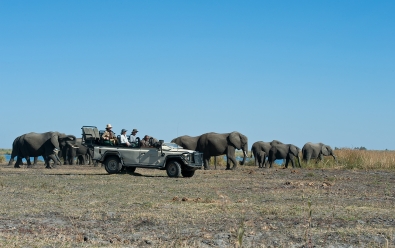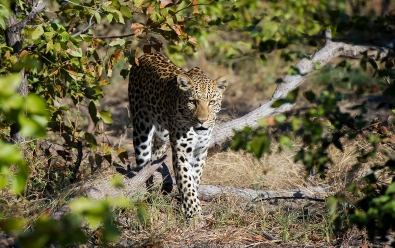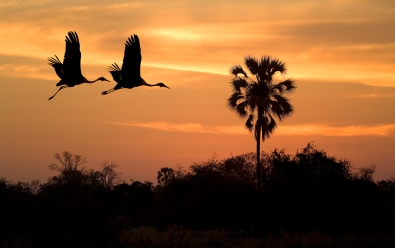Little DumaTau Camp
Highlights
- Superb wildlife area, especially during the dry season months.
- Day and night safari drives, boating, seasonal walking.
- One of the best places to see predators, including African wild dog.
- Small and intimate - ideal for a family or small group.
Location
- NG15 Private Concession
- Linyanti Wildlife Reserve
- Northern Botswana
Little DumaTau is a small, 4-tented camp located overlooking Osprey Lagoon in the wild and untamed Linyanti Reserve.
Little DumaTau is situated in the 490-square-mile (1 270-sq-km) Linyanti concession, which borders the Chobe Game Reserve and offers a diverse experience, including day and night game drives, boating, fishing, and seasonal walking with a guide. The concession includes a range of habitats, including permanent and seasonal swamps, savanna grassland, seasonally flooded plains, riparian forest, and open woodland. Game drives can also traverse a short distance south to explore the wildlife-rich Savute Channel.
The game viewing at DumaTau is outstanding, particularly during the dry winter and early springtime (from July thru October). Large numbers of elephant remain in the area near the Linyanti River, which they visit twice daily to drink. Herds of red lechwe can be seen all year along the river and impala are abundant on the floodplains, followed by their primary predator, African wild dogs.
Other wildlife commonly seen at DumaTau includes zebra, giraffe, hippo, greater kudu, sable antelope, roan antelope, reedbuck, waterbuck, blue wildebeest, and warthog. Predators that are likely include lion, spotted hyena, leopard, black-backed jackal, African wild dog, and crocodile. The area is superb for birding, with a high density of raptors, grassland and woodland species, as well as water birds.
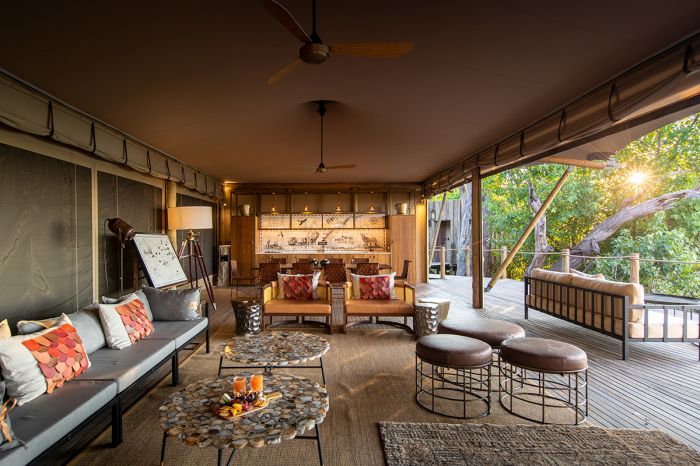
Main area lounge at Little DumaTau.
Little DumaTau is sited along the Linyanti River, overlooking a large body of water known as Osprey Lagoon. The river and lagoon attract wildlife, especially elephants, which come to drink, bath, and frolic in the water. The camp is spread out amongst the riparian forest lining the bank of the lagoon and each private guest room has unrestricted views over the water. The camp's name means "roar of the lion" in the local Setswana language.
Little DumaTau offers just 4 spacious tented guest units. The tents are connected by elevated wooden walkways that lead to the main camp area. The guest rooms have private wooden decks with a plunge pool and offer views onto the lagoon.
The main dining, lounge area and main area pool are raised to maximize the vista onto Osprey Lagoon. Little DumaTau is the smaller and more intimate sister camp to the larger main DumaTau Camp, located directly west. The two camps are connected by a raised wooden walkway and share a Wellness Center and gym.
Wilderness Safaris are one of Africa's leading safari operators and they strive to minimize energy consumption at all their camps. DumaTau and Little DumaTau are powered by a hybrid system, which combines solar power and a diesel-powered generator. Strict eco-friendly environmental standards are maintained so that no harmful chemicals or waste is allowed to enter the pristine ecosystem of the Linyanti Reserve.
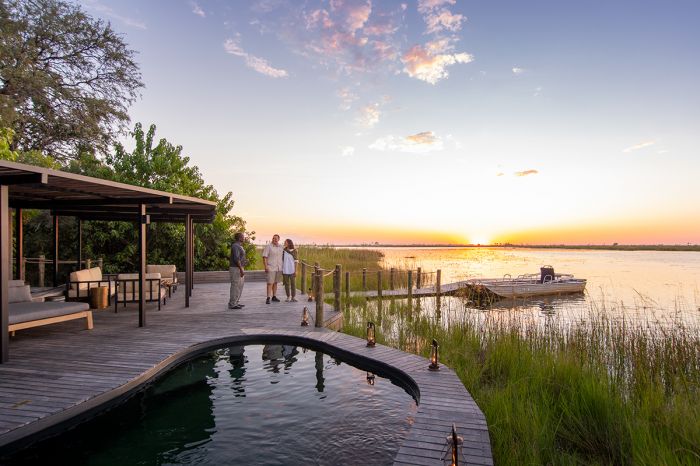
Main area deck overlooking the lagoon.
the Northern Reserves (Linyanti, Kwando, Selinda)
Located directly to the north of the Okavango Delta are three superb wildlife reserves: the Linyanti, Selinda, and Kwando. All three reserves offer superb game viewing in huge wilderness areas with very low tourist numbers. Each of the reserves has a number of safari camps and they all pair superbly with a visit to one more more camps in the Okavango. Daily charter flights are available from any of the camps in the Okavango Delta or elsewhere in northern Botswana.
Similar to the Okavango Delta, the northern reserves receive water from rivers fed by rains in northern Angola, the amount varying year to year. The Kwando River forms the border between Botswana and Namibia, and much like the Okavango River further west, it also empties into a trough of Kalahari sand, creating the Linyanti Swamp, a much smaller version of the Okavango Delta. The Linyanti Swamp empties eastward into the Linyanti River, which becomes the Chobe River further to the east.
In some years, and usually in multi-year cycles, the rain water flowing down the Kwando River is sufficient enough to cause the Linyanti Swamp to overflow to the south, where it may flow east into the Savuti Channel or southwest into the Selinda Spillway. The Savuti Channel empties into the Savute Marsh in Chobe National Park. The Selinda Spillway flows back into the northern part of the Okavango Delta.
Both of these waterways have historically gone through long periods of total dryness, becoming rich grasslands, and then suddenly flowing with water again, bringing rich sediments and new water along their courses. Like the Okavango, water flows are dynamic over time, with rains in the Angolan highlands and tectonic movements far beneath the surface of northern Botswana affecting the quantity and direction of the water in these river systems.
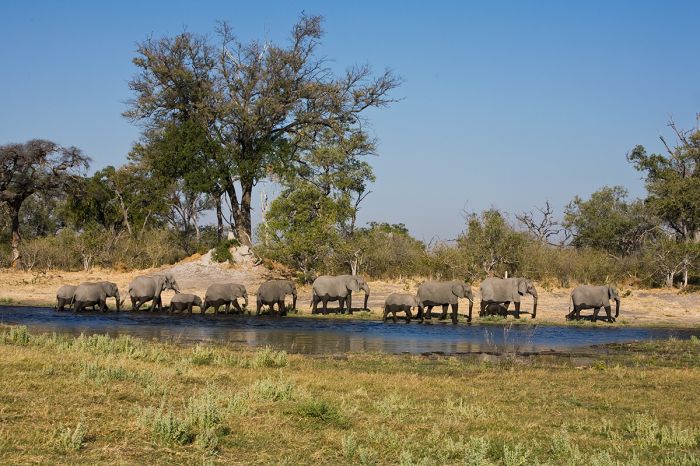
The Linyanti Reserve is home to a large population of elephants.
Away from the major rivers in the northern portion of these reserves, the southern portion of the northern reserves is dominated by dry woodland, consisting of Kalahari apple-leaf bush, mopane trees and Acacia trees on deep Kalahari sand. Elephants wander through as they travel between the Okavango and the northern rivers, and there are impala, greater kudu, roan antelope, sable antelope, but this area is mostly not used for safaris, with the safari camps located along the waterways to the north.
Wildlife viewing along the waterways in the northern reserves is outstanding, particularly between July and late October, when the bush is dry and the animals stay close to the permanent water. Elephants gather in large numbers at this time and head to the waterways to drink twice daily, sometimes swimming and playing in the deeper water. Herds of buffalo, zebra, and impala are also present in good numbers. Other herbivores include include greater kudu, giraffe, red lechwe, tsessebe, waterbuck, blue wildebeest, and warthog.
Common predators include lion, leopard, spotted hyena, black-backed jackal, and African wild dog. The northern reserves are one of the best places in Africa to see the wild dogs, which have their young around June each year, the pups are truly something to see if you get lucky. Cheetah are here in modest numbers and can be seen in the open grassland areas. Hippo and crocodile are abundant in the Kwando, Linyanti, and Chobe Rivers, as well as in the Linyanti Swamp area. Chacma baboon and vervet monkey are found in the riparian forests.
Birding in the northern reserves is outstanding, with a diverse mix of grassland, woodland, raptors, and water species found. A typical safari day can easily produce 100 species.
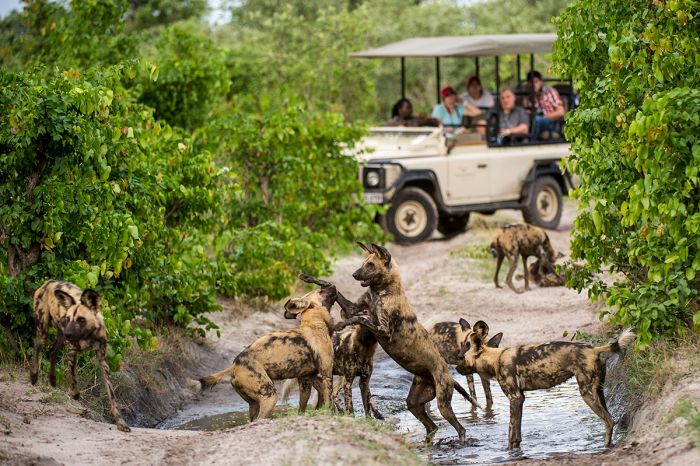
The Northern Reserves are one of the best places to see African wild dogs.
ROOMS INCLUDES & EXCLUDES CHILDREN FACILITIES ACTIVITIES
Accommodation
4 guest accommodations in total comprising:
- 4 twin-bedded luxury tents, each with two twin beds. Mattress converters are available that transform twin beds into a king-size bed (to be arranged prior to arrival).
Each luxury canvas-tented accommodation is constructed atop elevated wooden decking with views of the lagoon. En-suite facilities include a cottage-paned double indoor shower, double indoor shower, an outdoor shower, a double-vanity basin, and separate toilet.
The units are connected to the main camp area by elevated wooden walkways (intermittent sections are on the ground to allow for animal movement).
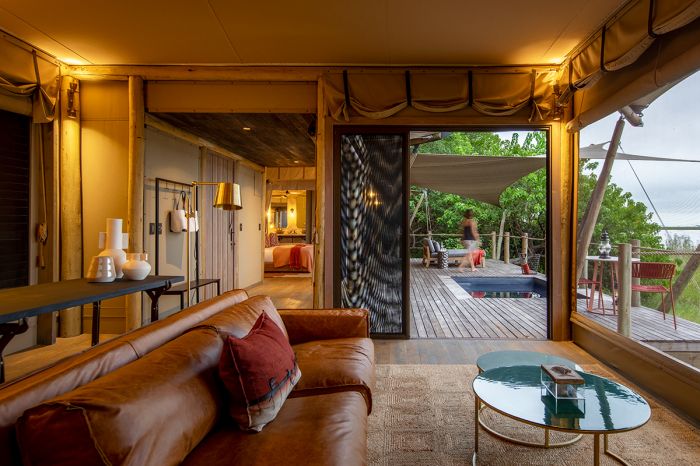
Guest room showing lounge, private deck, and view to bedroom.
Guest suite amenities include easy chairs, canvas blinds that roll up and down for all weather conditions, multi-plug charging facilities, an outdoor sala, outdoor sunken lounge area, and mosquito netting for the beds. Hot water bottles and extra blankets are provided during the chilly winter months.
Other items and features in the guest units include:
- Electronic safe.
- Mini-bar.
- Tea and coffee making facilities.
- Hairdryer.
- Spot cooling system provided in each tented suite, over the bed.
- Indoor lounge area.
- “Gym in bag” - includes a Pilates mat, free weights (2x 1-kg and 2x 2-kg), and resistance bands.
- Sala on deck.
- Outdoor lounge area.
- Private plunge pool.
- In-tent Wi-Fi.
- Internal telephone system for emergency assistance.
- Personal amenities, including seasonal bathrobes, slippers, liquid soap, body wash, shampoo and conditioner, body lotion, room spray, insect repellent, mosquito coil, shower caps, vanity kit with cotton-tip swabs, cotton wool pads, nail emery board, sewing kit, tissue dispenser, laundry bag, and umbrella.
Little DumaTau Camp can accommodate a maximum of 8 guests in total: 2 persons in each of the 4 tented rooms.
Includes & Excludes
Includes:
- All meals and local beverages including wines, spirits and liqueurs, but excluding premium imported brands and Champagne.
- Twice-daily safari drives in open game-viewing vehicles and other scheduled camp activities (accompanied by experienced guides).
- Laundry services are provided on a daily basis (weather permitting, items will be returned on the same day). Laundry is dried by the sun and on most days any laundry placed out in the morning will be returned by the evening.
- Wi-Fi access.
- Tourism Levy & VAT.
Excludes:
- Purchases from the Safari Boutique.
- Premium imported beverages and Champagne.
- In-room massage treatments.
- Scenic helicopter flights ranging in duration from 30, 45 to 60 minutes - with a minimum of 2 guests and a maximum of 3 (activity takes place between 11:00 and 15:00 when animal densities are high).
- Any applicable wildlife fee, park fee, reserve fee, concession fee, other land-use fee.
Single Supplement
A single supplement will apply for any room booked by a single traveler; please ask us for pricing.
Children
Children aged 6 years and older are accommodated at Little DumaTau:
- For families traveling with children between 6 and 12 years, sole use of the camp must be booked and paid for. Note that there is a family unit at DumaTau Camp, which sleeps 2 adults and 2 children and is within walking distance of Little DumaTau.
- Children between 6 and 16 years must share with an adult/s in the same room.
- The minimum age for boating activities is 6 years (water levels permitting).
- The minimum age for mokoro activities is 13 years (water levels permitting).
- The minimum age for walking activities is 13 years (subject to season and the availability of a qualified walking guide).
- The minimum age for spa treatments is 12 years. Note that treatments for children/teenagers (12-16 years) will be lighter in pressure, softer oils used, and may be shorter in duration depending on the needs of the child/teenager.
Facilities
Main guest area facilities include:
- Lounge, dining, and bar areas under canvas and on a raised wooden deck with wide-open views overlooking the lagoon.
- Star-deck for pre-dinner drinks and/or private dining.
- “Curiosity Room” where guests can explore, browse, read and be enveloped by the wealth of wildlife and rich history of research across the Linyanti Wildlife Reserve (located at DumaTau Camp).
- Pool in the main area with partially shaded deck.
- Lap pool in the Wellness Centre area with partially shaded deck.
- A pair of Olympus binoculars is available in the main area.
- Wellness Centre with air-conditioned spa and gym: equipment includes one stationary exercise bicycle, two treadmills, a rowing machine, an adjustable abdominal bench, exercise mats, Pilates balls, skipping rope, a range of free weights, and kettle bells). Fridge in gym with isotonic drinks. Shower rooms located off to the side. Shared with DumaTau Camp.
- The Osprey Retreat (a drinks and snack counter) located in same location as the Wellness Centre and shared with DumaTau Camp.
- Safari Boutique, shared with DumaTau Camp.
- Campfire with seating.
- During winter months, knee blankets are provided during dinner.
- Star-deck for pre-dinner drinks and/or private dining.
- Guest toilets in the main area.
Activities
Activities included in the rate:
- Day and night game drives in 3x 6-seater open 4x4 Land Cruisers. Note that standard policy is 4 guests per vehicle to ensure a more exclusive experience.
- During winter months, hot water bottles (on early morning game drives only), blankets, and lined ponchos are provided.
- A pair of Olympus binoculars is available in each of the game drive vehicles for guests to share amongst themselves whilst game viewing and may be requested from our guides.
- Birding.
- The camp has a supply of bean bags for guests to use to steady their camera while on a safari drive.
- Guided nature walks, seasonal and on request, subject to the availability of a qualified walking guide. Requests are subject to the discretion of the Camp Manager.
- Water-based activities in 1x 6-seater and 1x 8-seater motor boats (water levels permitting), plus an 8-seater barge for lunches, picnics and sundowners.
- Fishing on a catch-and-release basis year-round (except January and February, when fishing is barred by law for breeding). The camp has a small stock of basic rods and reels, whereas all fly fishing equipment is to be supplied by the guest if required.
Optional activities at additional cost:
- Private activities are on offer (subject to vehicle availability which needs to be booked in advance).
- Scenic helicopter flights ranging in duration from 30, 45 to 60 minutes - operated in a Robinson with guest numbers as a minimum of 2 and a maximum of 3 (activity takes place between 11:00 and 15:00 when animal densities are high).
Example of a typical day:
- Early morning wake-up call. Morning wake-up and activity times vary according to the seasons, activities on offer, and wildlife sightings.
- Light breakfast before departing on the morning activity.
- Return to camp for a meal and rest period.
- Meet for afternoon tea and snacks (savory and sweet choices) before departing on the activity.
- Return to camp - freshen up or meet for drinks, followed by dinner.
- Enjoy a nightcap or discussion around the fire before retiring.
Great Good Fair Poor
- Jan
- Feb
- Mar
- Apr
- May
- Jun
- Jul
- Aug
- Sep
- Oct
- Nov
- Dec
WHEN TO GO
The Linyanti region of northern Botswana offers excellent wildlife viewing opportunities throughout the year, but there are definitely seasonal variations in terms of weather and the densities of wildlife that may be a consideration when planning your visit.
The high season in terms of tourist demand is during the dry months between June and October. The latter part of the rainy season (February through April) is the low season.
The winter (June through August) is dry and cool and wildlife may be easier to locate as rain water is evaporating and the Linyanti, Kwando, and Chobe rivers and and substantial waterholes become more frequently visited by the animals as water becomes more scarce.
During the middle and later stages of the rainy season, the grass becomes tall and the bush becomes lush and thick, which makes for lovely colors, but makes spotting wildlife more difficult.
Little DumaTau is open year-round.
Summer / Rains
Northern Botswana, including the Linyanti region receives most of its rain between December and February, which is the summer season. November and December are superb months to visit the Linyanti, with only occasional rainstorms and most rain coming in short showers, bringing welcome relief to the thirsty land after the dry season.
January and February typically experience afternoon downpours on most days, but all-day rains are uncommon. By the middle of March, the rains become much less frequent and the grass and bush have grown long and thick. Mornings become cooler by the end of March.
In spite of being summer, the rains keep temperatures from becoming overly hot, although humidity and insect life are at their peak. Days are mostly overcast or partially cloudy, with dramatic skies and a lovely green color to the landscape. Afternoon temperatures average 88°F (31°C), but mornings are very comfortable at around 65°F (19°C).
Baby animals are in abundance, especially impala lambs and warthog piglets. Migratory birds arrive to breed and dramatically increase the number of species and overall numbers, particularly in the lagoons and pans, which are full of rain water and food for the aquatic species.
Unlike the dry months (May through October), when the middays can be very warm, causing wildlife to minimize activity and seek shade from around 10am til mid-afternoon, the overcast skies during the summer often mean that animals are active throughout the day, offering many more hours of game viewing.
Autumn
March, April and May are Fall season months and the beginning of the dry season in the Linyanti, with rains very uncommon from around mid-March. The landscape is still lush and green, with sunny days and comfortable temps; afternoons average 84°F (29°C). Mornings are comfortable, but a fleece and base layer may be needed for the first hours on game drive.
Migrant birds fly north and water in the lagoons and rain pans is drying up. Permanent waterways, including the Kwando, Linyanti, and Chobe rivers, are actually rising however, as the 'flood' water from the Angolan highlands is now reaching into northern Botswana. As a result of the rains abating and the waterholes away from the river becoming dry, animals begin to spend their time closer to these rivers, and wildlife sightings become better and better.
Morning temps are around 54°F/12°C and afternoons average 79°F/26°C.
Winter / Dry Season
June through August is winter and the vegetation is drying and going dormant. The water in the Linyanti/Chobe river system is peaking but the surrounding landscape is mostly brown and yellow. Dust and sand particles in the air is on the rise. Game viewing is superb, with elephant and buffalo herds congregating along permanent water.
Mornings can be chilly to very cold at around 45°F (7°C). Warm clothes, including winter hat and gloves are needed for the open-air game drives. Dress in layers, as the temps do rise quickly during the day, with middays reaching 79°F (26°C).
Wildlife sightings are superb in the Linyanti during the dry winter months.
Spring
September and October are the driest months as the landscape and animals eagerly await the coming rains. Game viewing is phenomenal, with all rain pans now completely dry and animals are congregating around permanent waterways, particularly along the Linyanti, Kwando, and Chobe Rivers. The grass and vegetation are very dry.
Days are warm, sunny, and often cloudless and by mid-morning, most animals are seeking shelter in the shade and awaiting the evening temps to drop. October can be brutally hot and dusty and even smoky as sporadic grass fires can occur.
Safari camps are mostly full to capacity, with guests adhering to guide books saying this is the only time to visit (not true of course). Temperatures in October can easily reach 95°F (35°C) or even hotter. Game viewing is superb.




